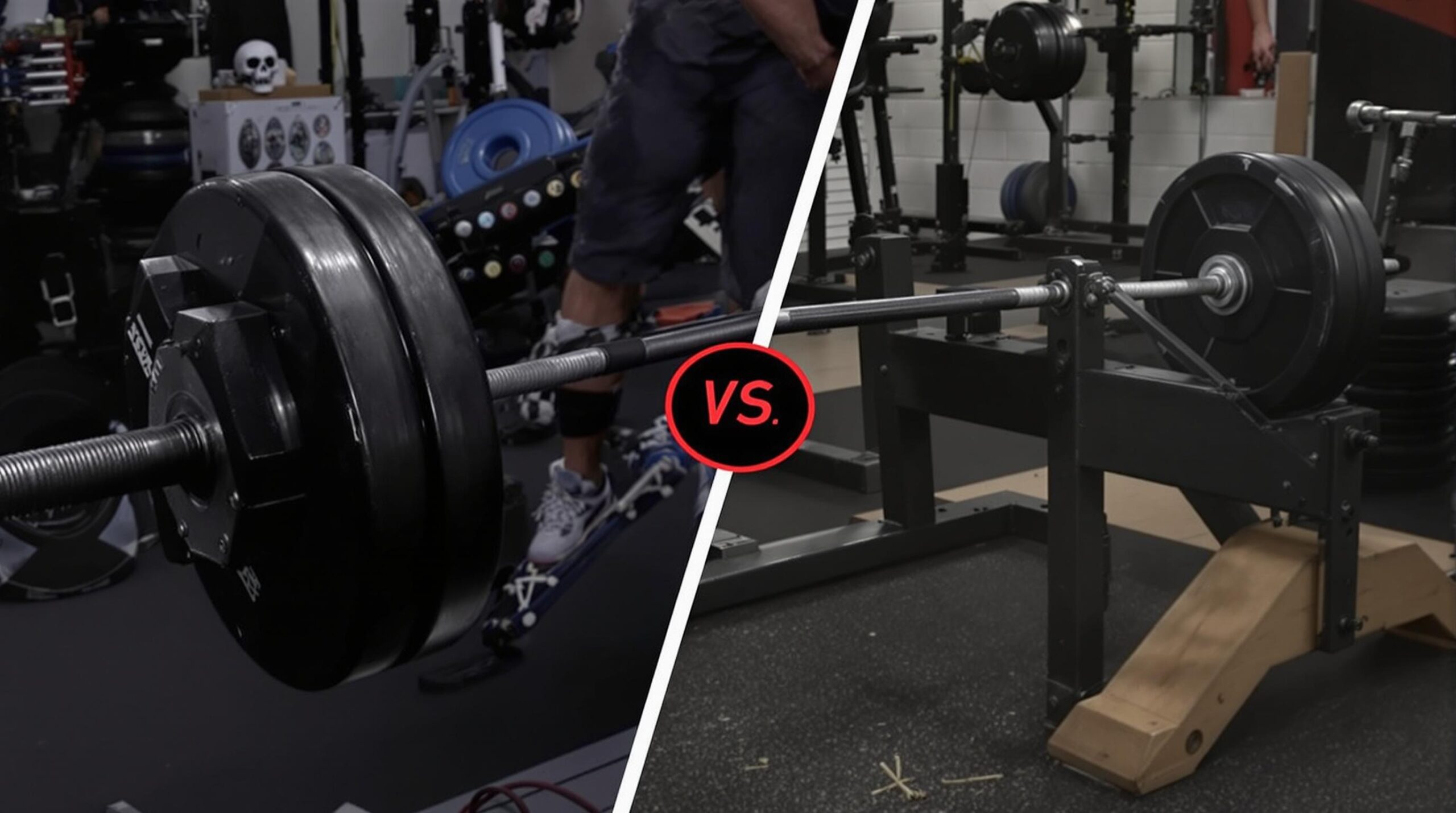Hex bar and trap bar deadlifts represent a significant evolution in weightlifting equipment, offering unique biomechanical advantages over traditional barbell deadlifts. These hexagonal-shaped implements allow lifters to stand inside the apparatus, creating a more natural lifting position that can boost performance while potentially reducing injury risk compared to conventional deadlifts.
Key Takeaways
- Hex and trap bars enable a more upright torso position, reducing stress on the lower back while increasing quadriceps engagement
- Lifters can typically handle 5-10% heavier loads with hex/trap bars compared to conventional barbell deadlifts
- The neutral grip design significantly decreases risk of bicep tears common with mixed-grip barbell deadlifts
- Hex/trap bars produce greater peak power and velocity, making them ideal for athletes in explosive sports
- The design variations between high and low handles allow customization based on mobility limitations and training goals
What Are Hex and Trap Bars?
Despite often being used interchangeably, hex bars and trap bars refer to the same basic piece of equipment – a hexagonal-shaped lifting apparatus that allows the lifter to stand inside the frame rather than behind the bar. While minor design differences exist between specific models, both feature a hexagonal or diamond shape with handles on either side.
The key difference between these specialized bars and traditional barbells lies in how the weight is distributed around the lifter rather than in front of them. This positioning creates a more balanced lifting experience that can be customized for various workout programs and training goals.
Most hex/trap bars feature dual handle positions – standard lower handles and raised higher handles. This design element allows lifters to adjust the range of motion based on their mobility, experience level, or specific training objectives. The high handles reduce the total lifting range by approximately 4-6 inches, which can be particularly beneficial for beginners or those with flexibility limitations.

Biomechanical Advantages: Movement Patterns and Form
The design of hex and trap bars creates significant biomechanical advantages that explain their growing popularity in strength training programs. Research shows that these specialized bars enable a 15-20° more upright torso position compared to conventional deadlifts, which reduces stress on the lower back.
When using a hex or trap bar, hip flexion decreases by approximately 10° while knee travel increases by 5-8 cm. This shifting of joint angles creates a movement pattern that exists somewhere between a traditional deadlift and a squat, making it a highly versatile exercise for overall lower body development.
The freedom to stand inside the bar allows lifters to adjust their stance to emphasize either:
- A more hip-dominant pattern (similar to conventional deadlifts)
- A more quad-dominant pattern (closer to squat mechanics)
- A balanced hybrid approach that targets both muscle groups effectively
This versatility makes hex/trap bar training particularly valuable for developing well-rounded strength similar to elite athletes who require both posterior chain power and quadriceps development.
Muscle Activation: Quad-Dominant vs. Posterior Chain Development
One of the most significant differences between hex/trap bars and conventional barbells is the pattern of muscle activation they produce. EMG studies have demonstrated that hex/trap bars increase quadriceps activation by 23-28% compared to straight bars.
Research published by Camara et al. showed vastus lateralis (a primary quadriceps muscle) activation reached 1.19 normalized units with hex bars versus only 0.97 with straight bars during the concentric (lifting) phase. This makes the hex/trap bar deadlift an excellent complement to other lower-body exercises in a comprehensive gym workout plan.
While quad activation increases, posterior chain engagement remains significant but differs from conventional deadlifts:
- Biceps femoris (hamstrings) activity decreases by approximately 28%
- Erector spinae (lower back) activation is about 9.2% lower
- Gluteus maximus engagement remains relatively consistent between both bar types
Interestingly, a 2016 study found that quad activation in hex bar deadlifts actually surpassed that of squats in some lifters, highlighting the effectiveness of this variation for balanced lower body development.
Strength and Power Benefits: Why You Can Lift More
Most lifters discover they can handle heavier loads with a hex/trap bar compared to a conventional barbell. This isn’t just a subjective feeling – research confirms this advantage, with most individuals able to lift 5-10% more weight using the hex/trap bar.
For example, a lifter with a 400lb barbell deadlift max might achieve 440lbs with a trap bar. This increased loading capacity stems from the improved leverage created by standing inside the bar rather than behind it, which allows for a more mechanically advantageous position.
Beyond absolute strength, power production shows even more dramatic improvements. At 80% of one-rep max, hex/trap bars generate:
- 8.4% greater peak power output
- 12% higher bar velocity
- Improved force-velocity curve for explosive strength development
These power advantages make the hex/trap bar particularly valuable for athletes in sports requiring explosive strength, such as sprinting, jumping, and throwing events.
Injury Prevention: Protecting Your Back and Joints
Perhaps the most compelling reason many coaches and physical therapists recommend hex/trap bars is their potential for reducing injury risk. Research indicates that lumbar shear forces are 16-28% lower with hex/trap bars compared to conventional deadlifts.
In quantifiable terms, studies have measured a reduction from approximately 3.2 kN with barbell deadlifts to 2.4 kN with trap bar deadlifts. This significant decrease in spinal loading can be crucial for lifters with a history of back problems or those looking to minimize injury risk.
Additional injury prevention benefits include:
- The neutral grip reduces bicep tear risk by approximately 34% compared to the mixed grip commonly used in barbell deadlifts
- Peak spinal flexion moments are 9.2% lower, reducing disc compression
- More balanced loading pattern distributes stress more evenly throughout the kinetic chain
By centering the load with the body’s center of gravity, the hex/trap bar creates a more spine-friendly lifting pattern without sacrificing training intensity or effectiveness.
Practical Applications for Different Goals
Depending on your specific fitness objectives, hex and trap bars can be programmed in various ways to maximize results. Here’s how to optimize their use based on different training goals:
For muscle growth (hypertrophy):
- Use low-handle hex/trap bars for maximal range of motion and quad development
- Implement moderate rep ranges (8-12) with controlled tempos
- Pair high-handle trap bar deadlifts with posterior chain accessories like kettlebell swings for balanced development
For strength athletes:
- Incorporate hex/trap bars for speed work and power development (3-5 reps at 65-75% 1RM)
- Use as an accessory to barbell deadlifts for powerlifters needing competition-specific strength
- Implement as a primary pull variation for non-competitive lifters prioritizing joint health
For injury-prone lifters:
- Prioritize hex/trap bars to reduce lumbar shear forces
- Use high handles during rehabilitation or for those with limited mobility
- Combine with other spine-friendly exercises like belt squats for comprehensive leg training
For athletes:
- Leverage the velocity advantages of trap bars for explosive sport performance
- Program more frequently than conventional deadlifts due to lower recovery demands
- Use varying loads to target different aspects of the force-velocity curve
Programming Recommendations: When to Use Each Bar
To maximize the benefits of both hex/trap bars and conventional barbells, consider these programming recommendations for different training populations:
Beginner lifters should start with trap/hex bars due to their more intuitive movement pattern and lower injury risk. The centered design creates a more natural lifting position that helps develop proper hip hinge mechanics before progressing to more technical barbell variations.
Athletes requiring explosive power will benefit most from prioritizing trap bar deadlifts for power development. The improved force-velocity profile makes this variation superior for developing the quick force production needed in jumping, sprinting, and change-of-direction activities.
Bodybuilders can optimize muscle recruitment by rotating between conventional and trap bar deadlifts. This approach ensures comprehensive development of the posterior chain and quadriceps while providing variety that can help prevent adaptive resistance.
Rehabilitating lifters should use high-handle positions to reduce range of motion while maintaining strength. This modified position allows for progressive loading with decreased stress on healing tissues, serving as an excellent bridge between rehabilitation and return to full training.
Competition powerlifters should primarily use the trap bar as accessory work while focusing on competition lifts. Since the conventional deadlift is contested in powerlifting, specificity demands prioritizing that movement pattern while using the trap bar for supplemental volume and fatigue management.
Choosing the Right Bar for Your Needs
When deciding between hex/trap bars and conventional barbells, consider these factors to make the optimal choice for your specific situation:
Your primary training goals should heavily influence your selection. For pure muscle hypertrophy or athletic performance, the hex/trap bar often provides superior overall development. For powerlifting-specific training, the conventional barbell remains essential for sport specificity.
Evaluate existing limitations such as back issues, mobility restrictions, or specific sport requirements. If lower back pain is a concern, the reduced lumbar stress of hex/trap bars makes them the clear choice. Similarly, those with limited ankle or hip mobility may find the more vertical torso position advantageous.
Equipment variations between models can significantly impact your



